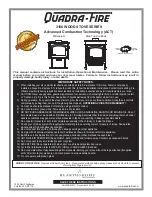
24
DK ENG
1.8 Connecting to a steel chimney
If your installation involves taking the chimney straight up and through the ceiling, you must
comply with National, Local Building Regulations or flue manufacturers instructions concern-
ing clearances to combustible materials such as walls, floor joists and ceilings. The joint be-
tween the stove flue collar and the stovepipe must also be sealed using the glass fibre rope
provided. It is important that the insulated flue system is properly supported both at ceiling lev-
el and at roof level.
THE STOVE MUST NOT BEAR THE WEIGHT OF THE CHIMNEY SYSTEM (See chimney manu-
facturer’s instructions). Excessive weight on the stove will inhibit expansion and could lead to
damage of the stove top. Damage caused to the stove in this way would not be covered by the
manufacturers guarantee.
If a chimney fire should occur as a result of incorrect operation of the stove or prolonged use of
wet fuel, close the vents completely and contact the fire brigade.
Fitting the S11-70 wall-hung version
note: The S11-70 wall-hung version may not be fitted to a wall made of combustible material.
The wall-mounting frame has 6 holes for mounting expansion bolts into the wall.
The bolts must be adequately sized and you must ensure that the wall is capable of suppor-
ting the stove. The weight of the empty stove is 70 kg (154 lbs).
It is therefore the responsibility of the installation contractor/customer to make sure that the
wall/chimney can support the stove securely. We point out that element block chimneys and
semi-brick chimneys without a lining do not always have the necessary carrying capacity. If in
doubt, you should contact a professional craftsman. The wall fitting, which is supplied in sepa-
rate packaging, can be used as a drilling template. Summary guidelines are supplied with the
wall fitting.
note: Plastic rawlplugs must not used due to the heat produced by the stove.
Mount the wall-mounting fixture on the wall. If the flue exit is wanted to the rear, build a wall
bushing correctly into the wall (see illustration).
Lift the wood stove in place so that it rests on the bottom part of the wall-mounting fixture, and
secure it again to the fixture by means of the screws included.
1.7 Connecting to a brick chimney
Brick a flue bushing securely into the wall, and insert the flue pipe into it. The pipe must not ex-
tend into the actual chimney opening, but only to the inside of the chimney aperture. The joints
between the stove/pipe and pipe/wall bushing must be sealed with the glass tape provided. It is
not normally necessary to seal between any pipe joints.
If the flue pipe transitions from horizontal to vertical, it is a good idea to install it with a gentle
bend so as to avoid any loss of draught.
The flue pipe must be dimensioned in accordance with national and local regulations. Morsø
recommends, however, that flue pipes be made of 2 mm sheet steel as this will extend the
service life.
Summary of Contents for S11-40
Page 18: ...18 NG...
Page 35: ...35 DK...
Page 36: ...36 NG Mors Jernst beri A S 12 09 2012 72114200 www morsoe com...













































